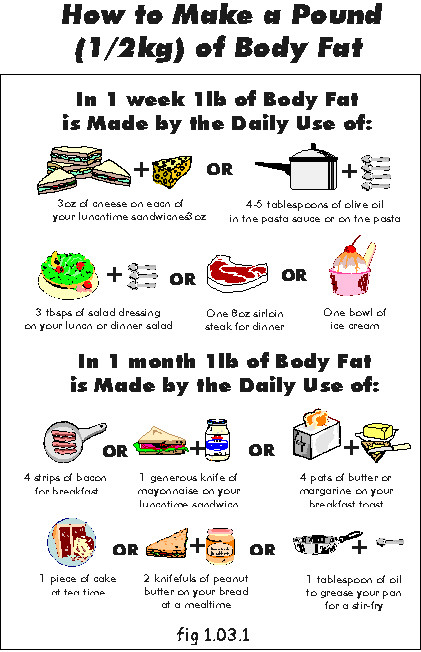 |
Its Time to Face the Fa(c)ts
As discussed briefly in the previous module, there is no way around the most important factor in weight loss and weight maintenance -- cut out processed, packaged fats! The reason why most westerners have such a passion for fatty food and meats is because of the taste. “Because fat is a solvent many organic molecules it can be a powerful flavorant, and besides this attribute fat provides a desirable mouth feel and contributes to the feeling of satiety after a meal. These attributes of fat have encouraged the use of increased quantities of fats in many traditional foods and made it extremely difficult for consumers to switch to a lower fat intake.” (Diet and Health, W. Veith, p.44).
90% of Fats Are Stored As Body Fat
The bad news for fat lovers is that, “unlike carbohydrates, approximately 90 percent of extra fat consumed during a meal is converted to body fat. Very fatty foods may also encourage overeating because more needs to be consumed in order to maintain the body's natural storage of glucose. Weight loss should therefore be directed toward a change in eating habits rather than dieting.” (Alternative Medicine, Compiled by the Burton Goldberg Group, p.767). “Everyone’s diet, no matter how unhealthful it is, is made up of a combination of carbohydrates, proteins, and fats. Since the body prefers carbohydrates as fuel, it will use them first. It will also burn some fats. However, since most of us live fairly sedentary lives, and at the same time eat lots of fat, much of what we eat will be transferred to fat cells for storage. The preferred destination of the fats in your diet is your adipose (fat) tissue, which lies just below the surface of the skin and surrounds your internal organs.” (Dr. John McDougall, The McDougall Program for Maximum Weight Loss, p.42). What our program suggests is flavouring food without fats and learning how to use herbs, natural fats and flavourants to flavour food.
It’s Easy to Make a Pound of Body Fat
“Since more than 90 percent of the fat you eat is being stored, it means you need to consume only 3,765 calories of fat to make one pound (approx. 1/2kg) of body fat. Under these circumstances, you need to eat only a few meals of fatty foods to add a pound of fat to your abdomen, hips, or thighs.”
Consider that in one week you could make a pound of body fat if you we to use the types of foods shown in fig 1.03.1 on aa daily basis. See fig 1.03.3 that indicates the percentage of fat in various foods.
The
most common mistaken food is cheese. Many people think that cheese is a
health food, providing calcium, protein, vitamin D and many more essential
nutrients. Cheese is so high in fat that it is practically indigestible.
It will be stored directly as fat when consumed. All animal products contain
saturated fats that clog up the arteries and are stored as fat.
 |
It's Not the Quantity of Food that Fattens, but the Quality
Dr
John McDougall, director of the McDougall Institute in California and author
of “The McDougall Program,” uses three glass stomachs filled with different
types of foods as an illustration of quantity vs. quality. He places food
to the same caloric value in each glass stomach and then points out how
the fullness of each stomach varies. Stomachs containing corn or potatoes
are filled to the top, whereas stomach containing different meats might
only be half full. Stomach containing fats, like salad dressing, mayonnaise,
butter or cheese, only have about a tenth of the stomach filled up. Yet
all these represent the same caloric value. See fig 1.03.2
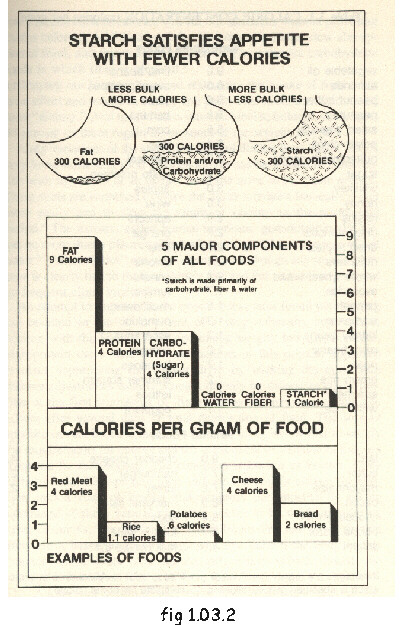 |
Dr Dean Ornish in his book, “Eat More Weigh Less,” states that “fat has over twice as many calories as either protein or carbohydrate. (Fat has nine calories per gram, whereas protein and carbohydrate on have four calories per gram.) So, when you reduce fat consumption from the typical American diet of 40 percent of calories down to the 10 percent fat levels in your diet, you can eat almost one-third more food yet take in the same amount of calories.” (Eat More Weigh Less, Dr Dean Ornish, p. 19, 20)
The Example of the Baked Potato
The book Dynamic Living, by A. Ludington and H. Diehl, gives an excellent example of how fat loads calories onto a baked potato. A big 8--oz potato, by itself, contains only 140 calories. That same potato when dressed with fat changes into a caloric bomb, see below:
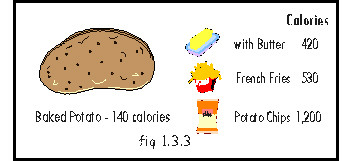 |
See how easy calories add up in a typical sample meal overleaf in fig 1.03.4. Also, take note of the percentage of fats in various foods in fig 1.03.5 and fig 1.03.6
Fats Have More Than Double the Calories
“All fats and oils are extremely high in calories -- 9 calories in every gram. And fat in foods adds very easily to your fat stores.” (Food for Life, Neal Barnard, M.D., p. 98).
Fig 1.03.2 is taken from “The McDougall Plan,” by Dr. John McDougall, p.23. It shows that fat has more than double the calories than carbohydrates.
“The
fats we eat, by contrast, have the greatest potential for increasing the
amount of body fat. Fats contribute more than twice as many kilojoules
per gram as either protein or carbohydrates...Fats are such concentrated
sources of kilojoules that it is difficult for the average body to burn
them all for energy. So the body efficiently converts excess food fats
into fat stores around the body.” (Eating for Peak Performance, R. Stanton,
p.16).
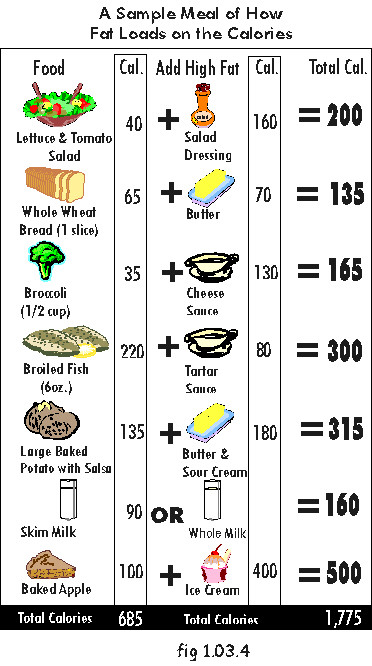 |
Does the Body Need Fats...And if so, Which Fats?
“Primarily a form of energy reserves in insulation in the body, fats can be burned to make energy when we need energy and are not getting enough from our diet. Fats are important in transporting other nutrients, such as vitamins A,D,E, and K -- the ”fat soluble vitamins." Fats are also an essential component of the cell membrane, and internal fatty tissues protect the vital organs from trauma and temperature change by providing padding and insulation." (Staying Healthy with Nutrition, Dr E. Haas, p.65).
Review again the foods that have high percentages of fat in fig 1.03.5 and the foods that have low percentages of fat in fig 1.03.6.
The simple rule of thumb is, if a fat is in its natural form, the body can use it...if it has been refined and processed, the body will store it away, either in the arteries or in the fats cells. In order to avoid a heavy scientific discussion on fats, we will divide fats into 3 basic groups:
Natural
Plant fats - fats which are still in their natural cell membrane, like
the fats found in avocado's, olives, soybeans, wheat germ, sunflower and
sesame seeds and the fats found in unroasted nuts. In other words, these
fats haven't been touched by the food industry and are found in plant sources.
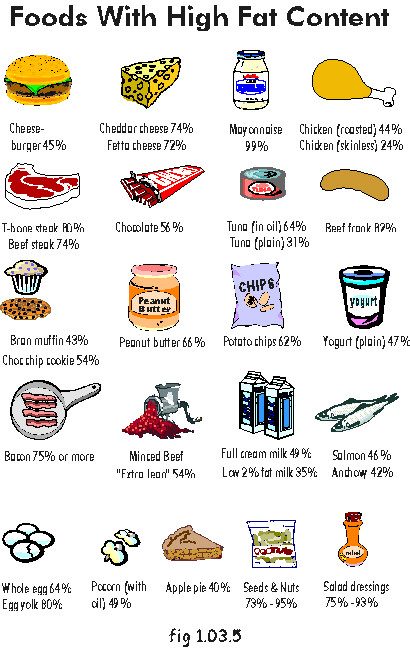 |
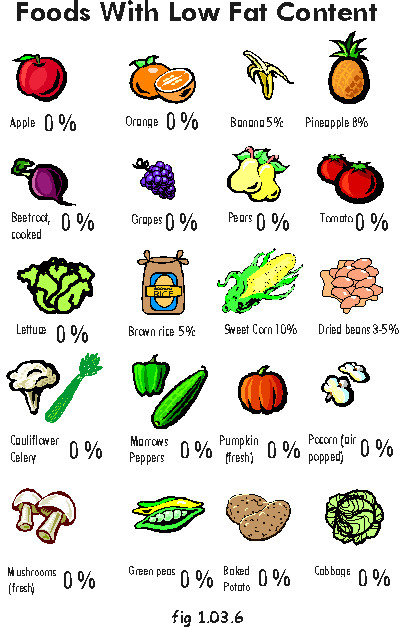 |
Processed Plant Fats - these are fats that have been removed out of their natural, original plant state or source. For example, sunflower oil, margarine, mayonnaise, salad dressings, and any bottled or packaged fat. The only processed oils that can be used in moderation, are the cold--pressed oils that can be bought in health shops. Generally true cold--pressed oils should go rancid within a few days and should be refrigerated. These oils are very rare and should also be used in moderation. Plant fats are what they term unsaturated as they are liquid at room temperature. In their natural state they are metabolized relatively easily by the body. When plant fats have been heated and processed, they take on more saturated characteristics and are difficult to metabolize. The body easily stores these and will use carbohydrates for its energy source. Fig 3.1.5 shows which foods have a very low fat content. You will notice that most of the foods are from plant sources.
Animal Fats - along with the processed fats, animal fats should also be cut out of the diet. Animal fats are saturated and are solid at room temperature. They are thick and greasy and clog up the arteries and will also be stored as body fat rather than be used as energy. Animal fats are found in all meats, red and white and in dairy products. Eg: Beef, Pork, Lamb, Poultry, Milk, Butter, Cheese, Eggs, Chocolate, Ice Cream, Yogurt.
More Reasons to Avoid “Bad Fats”
Fats Slow Down the Digestion and the Metabolism
For a person who is overweight, and already battling with a slow metabolism, processed and animal fats are very detrimental to their progress in weight loss. The reason is because fats greatly retard the digestion and metabolism.
All Meat From Animals Fattens
“The problem with meats, including poultry and fish, is that they are muscles, and muscles are made up of protein and fat. They contain no fiber at all and virtually no carbohydrate. Advertisers sometimes claim that chicken and fish are low--fat foods...Now matter how chicken is prepared, it cannot get its calorie level down to that of the truly healthful foods, because chicken, like all meats, is permeated by fat and contains no complex carbohydrates or fiber...And it should be remembered that fish oils are as fattening as any other oils or fats. Like all fats and oils, they contain nine calories per gram.” (Food That Cause You To Lose Weight, Neal Barnard, M.D., p.31). Review again the foods that have high percentages of fat in fig 1.03.5 and the foods that have low percentages of fat in fig 1.03.6.
Obesity and Dietary Fat is Linked to Many Diseases
“The
excess fat in food is being singled out as the most damaging component
of the Western diet. The deadly duo -- the high--fat, low fiber diet --
is now linked to such diverse problems as coronary artery (heart) disease,
gallstones, appendicitis, cancers of the colon, breast, and prostate, strokes,
constipation, diverticulitis, and gout, to name a few. And the list continues
to grow.” (Dynamic Living, A. Ludington, H. Diehl, p.114).
[HOME]
[BACK TO WEIGHT LOSS]